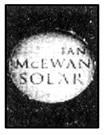
科目: 来源: 题型:阅读理解
查看答案和解析>>
科目: 来源: 题型:阅读理解
查看答案和解析>>
科目: 来源: 题型:阅读理解
查看答案和解析>>
科目: 来源: 题型:阅读理解
| Award?winning author Emma Donoghue's latest book, Room, is a unique and amazing story about a boy's experience living in a small,windowless room with his mother. The 11' x 11' space between the walls of the room is actually all the boy knows because he was born there and has never left. Room will horrify ,surprise, sadden, and finally delight you. Attracted from the start, readers of all sorts won't want to put Room down. ◆First published in the U. S. in September 2010 ◆Publisher: Little Brown ◆321 Pages |  |
| Literary master Ian McEwan returns with Solar, a novel about a Nobel prize?winning physicist. The physicist's personal life is in a mess as his fifth marriage breaks,but this time he actually loves his wife and wants to make things better. Solar is a funny story, completely unusual and as good as anything the writer has ever written. ◆Published in March 2010 ◆Publisher: Knopf Doubleday ◆304 Pages |  |
| One Day by David Nicholls was an international bestseller before it was released in the U. S. in June. Although it is well written and funny at times, don't be fooled—this isn't a good?feeling romantic comedy. If you decide to read it, be prepared for some heavy moments. ◆Published in the U.S. in June 2010 ◆Publisher: Vintage Contemporaries ◆437 Pages |  |
| Fall of Giants by Ken Follett is the first book in a new trilogy (three books)that will take readers through the major events of the twentieth century by following five families. In Fall of Giants, most of the action centers on World War I and the Bolshevik Revolution. Although Fall of Giants is more than 1,000 pages and has many characters,the story is remarkably connected. ◆Published in September 2010 ◆Publisher: Dutton ◆1,008 Pages |  |
查看答案和解析>>
科目: 来源: 题型:阅读理解
查看答案和解析>>
科目: 来源: 题型:阅读理解
查看答案和解析>>
科目: 来源: 题型:阅读理解
查看答案和解析>>
科目: 来源: 题型:阅读理解
查看答案和解析>>
科目: 来源: 题型:阅读理解
查看答案和解析>>
科目: 来源: 题型:阅读理解
查看答案和解析>>
湖北省互联网违法和不良信息举报平台 | 网上有害信息举报专区 | 电信诈骗举报专区 | 涉历史虚无主义有害信息举报专区 | 涉企侵权举报专区
违法和不良信息举报电话:027-86699610 举报邮箱:58377363@163.com